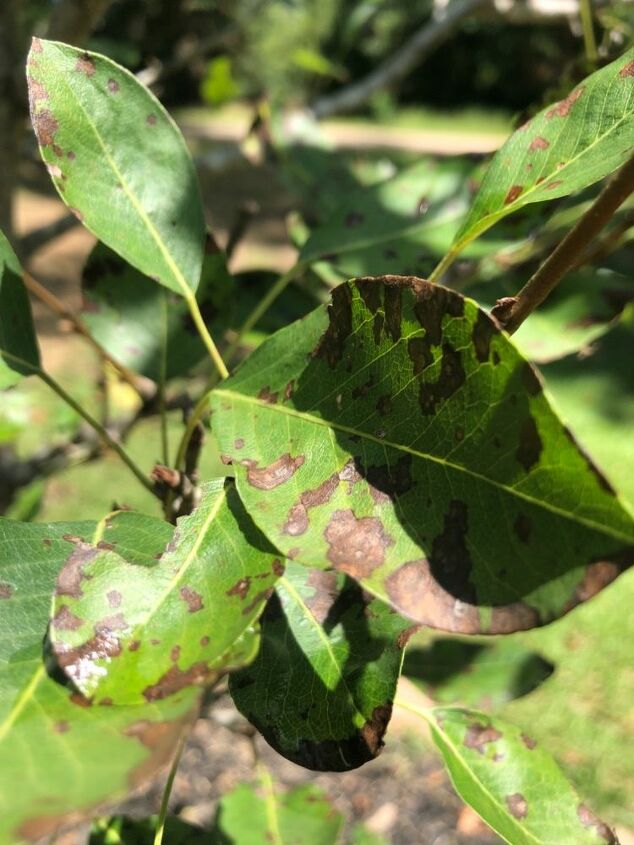How to save Bradford pear trees that have leaves turning black?
We have two bradford pear trees that are loosing their leaves. The leaves are turning black before they fall. How can we bring them back to life?
Related Discussions
GNATS - How to get rid of them?
Somehow my house and garden got tiny gnats that killed my fuchsia plant and fly everywhere. I have tried ALL the Web recommendations - soap and oil dishes, sand in th... See more
Marigolds growing! Should I pinch the buds?
My marigold plants are growing. I heard that pinching the buds until Autumn will allow them to grow without killing the plant. Is this true?
Growing garlic
Growing our first garlic, should we wait until the leaves are drying out before we pick it? Husband picked first one today along with our first potatoes.
How to keep mice out of your garden?
Hi everyone, I have mice in my garden destroying my vegetables and I have also noticed them in the barn and shed. Please can someone tell me how to prevent them from ... See more
What's the best flower/plant to grow in Texas?
I know that opinions vary, but what's your opinion?!I have great luck w Rosemary plants. Green all year long.
Why are the leaves of my pear tree turning brown (pic)?
I bought a home recently and this is what the pear tree looks like, I have no idea what could be doing this to it, I don’t know much about them, help please!!!
How do I stop tree stump from growing?
I have a gnarly old tree stump that has continued to grow from the trunk. My question is how do I stop it from sprouting all the way up the trunk. I break them off r... See more





Bacterial infection known as fire blight (Erwinia amylovora). Fire blight is irreversible and often fatal, but it can be controlled using a combination of manual and chemical treatments.Bradford pears are a highly invasive non-native to North America tree. Not only are these trees causing serious damage to native plants and shredding tractor tires, but they come with other problems as well. The trees were introduced by the United States Department of Agriculture as ornamental landscape trees in the mid-1960s. They became popular with landscapers because they were inexpensive, transported well and grew quickly.
Here are a few things to know about Bradford pear trees:
Bradford pear trees can be dangerous
They can grow up to 30 feet tall, which is dangerous because the trees have a weak branch structure. Bradford pear trees often break apart within 20 years, Anything, and anyone, under a Bradford pear is at increased risk as the tree ages and its steep V crotch structure is strained.
The Forestry Commission thru out the different southern states cautions against planting Bradford pear trees.
Callery pears are like kudzu
Crossbreeding of Bradford pears with other pear trees has caused a boom in Chinese Callery pears, which have long, thick thorns that can’t be mowed down by traditional tractors and can choke out native trees much the same way as kudzu.
More: Grab your chainsaw and end this Bradford pear curse once and for all
'Do not plant' Bradford pears
The South Carolina Forestry Commission has cautioned against planting the trees: “Do not plant Callery or Bradford pear. Instead, plant native alternatives, such as serviceberry, fringe tree, tupelo, or dogwood, among many others. Trees should be cut and stumps immediately treated with herbicides to eliminate sprouting response. Maybe it's time to get rid of them and plant something better local native species that will give back to the habitat in your area.Sorry about the rant.......It'll take some major work so here is way to help your trees. https://extension.uga.edu/publications/detail.html?number=C871&title=Fireblight:%20Symptoms,%20Causes,%20and%20Treatment
HI Donna, here's a great article that goes into some depth about why your leaves are turning black - http://blog.davey.com/2018/06/why-bradford-callery-pear-tree-leaves-are-brown-black-or-falling-off/
Sounds like a fungus or mildew problem. I would find a spray special for fruit trees since you do not want anything that is not eatable. Sometimes ordinary baking soda mixed with water will kill fugus or mildew but you must rinse it off again after about 10 minutes so it does not burn the good leaves. Do not spray in the not sun.
Our neighborhood was developed in the 1990’s. Every home got a Bradford pear tree. There are very few left. Most have lost MAJOR limbs or have succumbed to disease. They have a weak limb structure apparently. I’d get rid of them, especially if a limb could damage your house. We thought ours was healthy until a wind brought down half of it. You can’t necessarily tell by appearance.
Lynn Sorrell is right. Bradfords are a terrible pest to the U.S. Kill them now! Plant a nice tree.
Thank you to all that responded. Looks like we'll have to have both trees cut down.